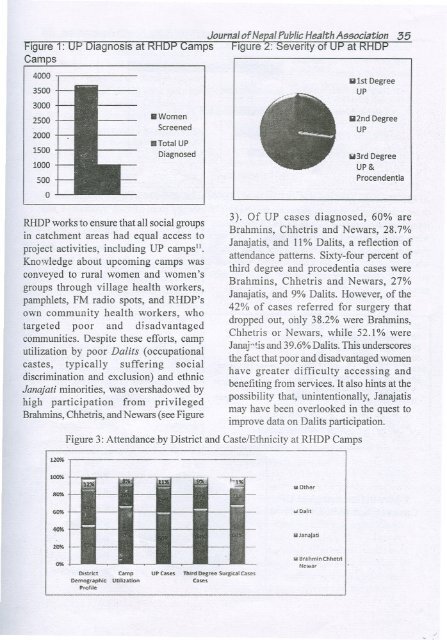Uterine Prolapse in Nepal: The Rural Health Development Project's
Uterine Prolapse in Nepal: The Rural Health Development Project's
Uterine Prolapse in Nepal: The Rural Health Development Project's
You also want an ePaper? Increase the reach of your titles
YUMPU automatically turns print PDFs into web optimized ePapers that Google loves.
Journal of Ne 81Public<strong>Health</strong> Association 85<br />
laanOSls ::I _mnC! .n..rn - -. --<br />
3000<br />
2500<br />
2000<br />
1500<br />
1000<br />
500<br />
0<br />
. Women<br />
Screened<br />
.Total UP<br />
Diagnosed<br />
lUst Degree<br />
UP<br />
112nd Degree<br />
UP<br />
113rdDegree<br />
UP&<br />
Procendentia<br />
.<br />
I<br />
I<br />
I<br />
,<br />
RHDPworks to ensure that all social groups<br />
<strong>in</strong> catchment areas had equal access to<br />
project activities, <strong>in</strong>clud<strong>in</strong>g UP Carl1.pSIl.<br />
Knowledge about upcom<strong>in</strong>g camps was<br />
conveyed to rural women and women's<br />
groups through village health workers,<br />
pampWets, FM radio spots, and RHDP's<br />
own community health workers, who<br />
targeted poor and disadvantaged<br />
communities. Despite these efforts, camp<br />
utilization by poor Dalits (occupational<br />
castes, typically suffer<strong>in</strong>g social<br />
discrim<strong>in</strong>ation and exclusion) and ethnic<br />
Janajati m<strong>in</strong>orities, was overshadowed by<br />
high participation from privileged<br />
Brahm<strong>in</strong>s,Chhetris, andNewars (see Figure<br />
3). Of UP cases diagnosed, 60% are<br />
Brahm<strong>in</strong>s, Chhetris and Newars, 28.7%<br />
Janajatis, and II % Dalits, a reflection of<br />
attendance patterns. Sixty-four percent of<br />
third degree and procedentia cases were<br />
Brahm<strong>in</strong>s, Chhetris and Newars, 27%<br />
Janajatis, and 9% Dalits. However, of the<br />
42% of cases referred for surgery that<br />
dropped out, only 38.2% were Brahm<strong>in</strong>s,<br />
Chhetris or Newars, while 52.1% were<br />
Janaj~~isand 39.6%Dalits.This underscores<br />
the factthat poor and disadvantagedwomen<br />
have greater difficulty access<strong>in</strong>g and<br />
benefit<strong>in</strong>g from services. It also h<strong>in</strong>ts at the<br />
possibility that, un<strong>in</strong>tentionally, Janajatis<br />
may have been overlooked <strong>in</strong> the quest to<br />
improve data on Dalits participation.<br />
Figure 3: Attendance by District and Caste/Ethnicity at RHDP Camps<br />
12('"<br />
,,,,",<br />
....<br />
. 0.."<br />
....<br />
..Dah.<br />
I<br />
'O!O<br />
""<br />
D".n"<br />
",_,.."'<<br />
""oM.<br />
Camp<br />
U.""1on<br />
UPeases .."" S"",lcalCases<br />
ca...<br />
.Jana)a.<br />
88,ahmlnChh..d<br />
No..",<br />
'"

















